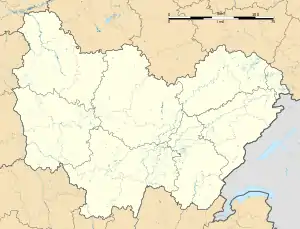Flavignerot | |
|---|---|
 The church in Flavignerot | |
.svg.png.webp) Coat of arms | |
Location of Flavignerot | |
 Flavignerot  Flavignerot | |
| Coordinates: 47°16′48″N 4°55′03″E / 47.28°N 4.9175°E | |
| Country | France |
| Region | Bourgogne-Franche-Comté |
| Department | Côte-d'Or |
| Arrondissement | Dijon |
| Canton | Dijon-6 |
| Intercommunality | Dijon Métropole |
| Government | |
| • Mayor (2020–2026) | Jean Dubuet[1] |
| Area 1 | 6.29 km2 (2.43 sq mi) |
| Population | 223 |
| • Density | 35/km2 (92/sq mi) |
| Time zone | UTC+01:00 (CET) |
| • Summer (DST) | UTC+02:00 (CEST) |
| INSEE/Postal code | 21270 /21160 |
| Elevation | 320–598 m (1,050–1,962 ft) |
| 1 French Land Register data, which excludes lakes, ponds, glaciers > 1 km2 (0.386 sq mi or 247 acres) and river estuaries. | |
Flavignerot (French pronunciation: [flaviɲʁo]) is a commune in the Côte-d'Or department in eastern France.
History
In antiquity, Flavignerot was originally an ancient Gallo-Roman settlement under its Latin name, Flaviniacum. Its nearby summit Mont Afrique was a camp site called Camp de Cesar, where the Roman senator Julius Caesar never set foot on the peak.
In 1979, the Carmel of Dijon monastery was relocated from Dijon to a hill near Flavignerot.[3]
Population
| Year | Pop. | ±% |
|---|---|---|
| 1962 | 50 | — |
| 1968 | 51 | +2.0% |
| 1975 | 72 | +41.2% |
| 1982 | 131 | +81.9% |
| 1990 | 165 | +26.0% |
| 1999 | 153 | −7.3% |
| 2008 | 171 | +11.8% |
See also
References
- ↑ "Répertoire national des élus: les maires" (in French). data.gouv.fr, Plateforme ouverte des données publiques françaises. 13 September 2022.
- ↑ "Populations légales 2021". The National Institute of Statistics and Economic Studies. 28 December 2023.
- ↑ "Carmel of Dijon at Flavignerot - Service des Moniales". 5 February 2016. Retrieved 17 May 2019.
Wikimedia Commons has media related to Flavignerot.
This article is issued from Wikipedia. The text is licensed under Creative Commons - Attribution - Sharealike. Additional terms may apply for the media files.